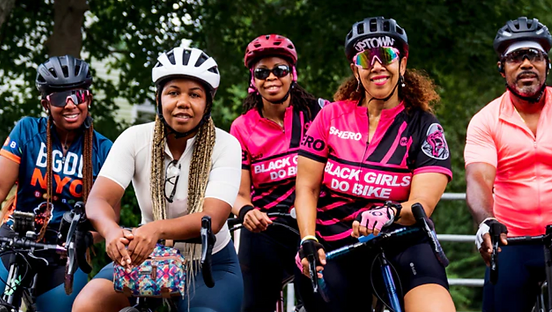Racial Healing and Sisterhood on Two Wheels
Share
Explore Our Galleries
Breaking News!
Today's news and culture by Black and other reporters in the Black and mainstream media.
Ways to Support ABHM?
Joseph Williams, Word in Black
By encouraging Black women to experience the freedom and joy of cycling, Black Girls Do Bike is also changing the complexion of a predominantly white, mostly male sport.

Growing up, riding a bicycle was one of Monica Garrison’s favorite summertime activities. The sense of excitement and freedom she felt on two wheels stayed with her into young adulthood when she commuted to and from work on her bike.
Then, life happened — her career, a family — and Garrison had less and less time for cycling. Eventually, she put down the kickstand and parked her bike.
During a particularly rough stretch of 2013, however, Garrison found herself feeling low, badly in need of some joy and a weight-loss routine. Her bicycle beckoned, she hopped back on and hasn’t stopped since then.
“I got what I was looking for, and I wanted to share that with other women who looked like me and perhaps shared similar struggles,” says Garrison, who lives and rides in Pittsburgh. “I was surprised that I rarely saw women of color on bikes while riding through my town.”
So she decided to be the change she wanted to see and started a Facebook page, looking for other women like her. She didn’t know it then, but Garrison’s page would lead to Black Girls Do Bike, a nonprofit dedicated to recruiting and celebrating Black women cyclists with more than 100 chapters worldwide — and counting.
The mission is “to introduce the joy of cycling to all women, but especially, women and girls of color,” according to BGDB’s website. But it’s as much a safety organization and a support group as it is a cycling club.
“We are establishing a comfortable place where lady cyclists can support and advise one another, organize rides, and promote skill-sharing,” according to the website.
Read more about the biking club in the original article.
Learn about another woman, June Jordan, who helped the Black community come together in this virtual exhibit.
Find more Breaking News here.









Comments Are Welcome
Note: We moderate submissions in order to create a space for meaningful dialogue, a space where museum visitors – adults and youth –– can exchange informed, thoughtful, and relevant comments that add value to our exhibits.
Racial slurs, personal attacks, obscenity, profanity, and SHOUTING do not meet the above standard. Such comments are posted in the exhibit Hateful Speech. Commercial promotions, impersonations, and incoherent comments likewise fail to meet our goals, so will not be posted. Submissions longer than 120 words will be shortened.
See our full Comments Policy here.